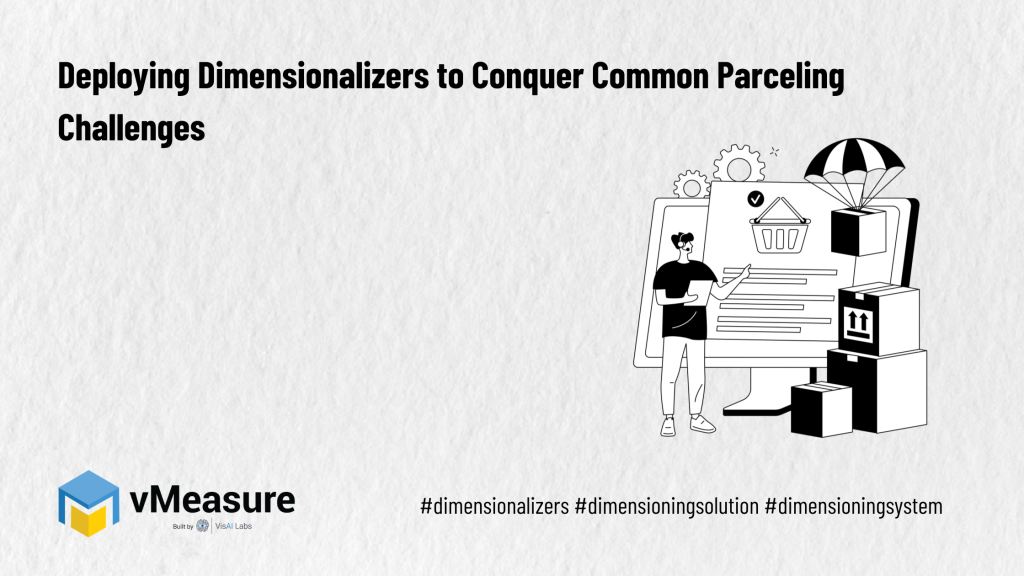Summary
- Online e-commerce was just starting up till approximately a year ago.
- With an internet-focused strategy, it is more important than ever to satisfy customers’ needs by giving them the correct products so they may shop comfortably from home.
- Various aspects must be taken care of before the clients receive the products, including packaging, shipping, and delivery.
- With automated dimensionalizers, parceling difficulties can be resolved.
- This blog post explains how parceling has become a challenging process and how deploying automated dimensionalizers can help firms conquer various parceling challenges in the workspace.
Introduction
The majority of well-known companies now do their business online. As a result, businesses must establish trust and strong customer relationships because they become famous international brands when they do.
While expanding, most of these industries encounter issues like space optimization, extra transportation costs, and parceling difficulties due to dimensions. Paying attention to different parceling obstacles might be beneficial if you are running an e-commerce company, are dealing with these problems, wish to improve your client service, and want to grow your firm.
What is parceling?
Packing two or more products in a single carton is called “parceling.” Depending on what is inside, the carton’s size can vary. These parceling techniques are used regularly to buy and distribute items around the globe. Additionally, compared to item-level analysis, parcels have significant statistical advantages.
Parceling – why is it so important to the warehouse?
For a delivery to be successful, the package must move smoothly from the warehouse to the customer’s door. Therefore, it is crucial to comprehend how a package travels. An increase in revenue follows an improvement in the warehouse’s development and productivity. Each parcel is important since its measurements define how much room must be optimized and how much transportation will cost. As a result, many warehouses try to select the best automated dimensioning solution.
What is an automated dimensionalizer?
Before a product parcel is shipped, warehouses use dimensionalizers, an automation technology, to calculate its volumetric dimensions, including height, breadth, width, and weight. These dimensionalizers are further classified into the parcel and package dimensionalizer; each dimensionalizer is deployed in different working areas based on the business requirements and working environment.
Adoption of dimensionalizers in warehouses has many benefits:
It is essential to comprehend the advantages before selecting the best dimensionalizer. You wouldn’t be able to choose a suitable dimensionalizer for your warehouse till after that. Below listed are some of the key benefits of using an automated dimensionalizer.
- A higher degree of accuracy: The word “accuracy” is crucial in the warehouse sector. Analyzing the precise measurements would allow the company to reduce unnecessary shipping tariffs, thereby increasing revenue.
- Reduced human error: Traditional dimensioning methods calculate the parcel’s dimensions using tapes and rulers. Due to this, certain inconsistencies could arise, resulting in unnecessary freight costs. Deploying automated dimensionalizers can reduce the risk of human error, improving the process’s efficiency.
Industrial benefits of using automated dimensioning solutions:
Automated dimensionalizers that do several functions, like estimating the weight and dimensions, scanning barcodes, and capturing parcel images, can benefit a variety of small- and large-scale warehouses, logistics, transportation, and postal businesses. Due to all of these considerations, the majority of warehouse companies choose dimensioning solutions for their projects.
Picking an ideal automated dimensioning system for your vertical
Incorporating new technology in your warehouse could seem daunting, and most employees no longer favor regular changes in the workplace. But with the help of a dimensioning system, you can now calculate dimensional data such as length, breadth, height, width, and weight. These dimensional data are crucial for calculating the shipping cost, estimating storage space, and so on. As soon as you have identified your ideal dimensionalizer, installing and integrating it into your existing system is vital.
Prior to choosing an ideal automated dimensioning system, you should ask the following questions:
- How should a dimensionalizer meet your needs?
- In what ways do you plan to utilize the dimensional data?
- Spending capacity on equipment.
- Equipment installation and integration
Because of the coronavirus pandemic, most work is now done online. One of them that is significant is e-commerce. Digital shopping has grown significantly, and it has both benefits and drawbacks. Focusing on each step, from ordering a product or service to getting it to the customer’s doorstep, is necessary for a successful shipment.
Familiar parceling challenges:
Most online e-commerce faces two recognizable challenges during parceling:
Increasing cost:
The owners and customers encounter an unfavorable expense problem throughout this stage. Dimensional weight rates are the main cause of the increased expenses experienced by large package enterprises. Therefore, it is typical to utilize this dimensional (DIM)weight-based density to calculate the package cost. The package’s height, length, and width are typically multiplied by the predetermined divisor to determine the DIM.
Most buyers anticipate receiving their product or item within a day or two. Most intermediary suppliers face challenges during this time, including unavailability and shipment distances. They also have additional difficulties, including transportation costs, gasoline costs, and surcharges dependent on the needs of the client.
Increased expenses caused by parceling familiarity issues:
Most online e-commerce encounters two observable difficulties while parceling:
When this is added up, the owners are forced to make more payments, which results in higher costs.
Delivery expectations:
eCommerce has been increasing in popularity recently due to quick and free delivery. The cherry on top is that this pandemic has demonstrated how feasible same-day and one-day delivery is. Additionally, depending on the shipment volume, the delivery might be performed in two to five working days.
On the other hand, several websites require users to select their preferred delivery day and time. Therefore, it is advantageous for business owners to protect the delivery schedule and restructure network-based distributions employing multi-node networks to approach the clients on an anticipated timeline.
Administrative necessities:
Employees who participate in this area deal with a variety of problems. They must take care of everything, including determining the kind and amount of packages that need to be delivered each day, keeping track of products, gathering customer feedback, and monitoring the product’s availability, including packing costs, transportation options, and shipment accuracy.
Conquering common parceling challenges with automated dimensioning solutions:
- Costs associated with shipping can be reduced: For most brisk business sectors, the cost is an important consideration. However, parceling may be accomplished quickly with the correct automated dimensioning technology. Furthermore, the dimensional data can be measured in less than a second, freeing up space to reduce idling costs.
- Barcode navigation made finding parcel locations easy: We can simply locate the parcel by integrating a barcode scanner with automated dimensioning technologies. In addition, giving clients a web connection to follow their orders independently helps keep them informed.
- Detects package defects: Identifying fragile or damaged merchandise is the greatest strategy to prevent consumer unhappiness. The solution estimates the fragile and defective products in less than a second using automatic dimensioning computation, which uses agile and simple dimensional data. The camera is fixed to record the image and aid in locating the problem in the package. These data are subsequently used for other measurement analyses.
Conclusion:
Industries must put in more effort as e-commerce spreads internationally to suit consumer demands. We have implemented several automation solutions to increase efficiency and reduce human error. However, most online merchants face an uphill battle to speed up delivery times. Nevertheless, we may quickly overcome the typical parceling difficulties by selecting the appropriate automated dimension solution.




